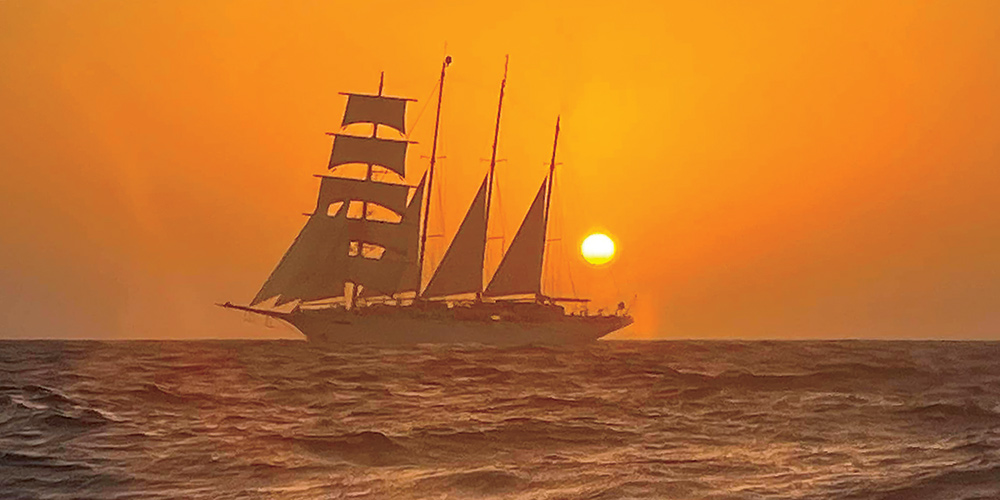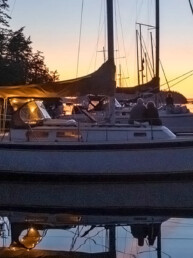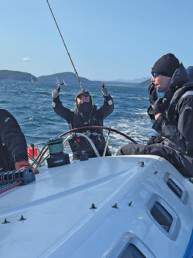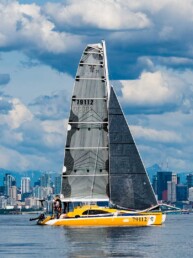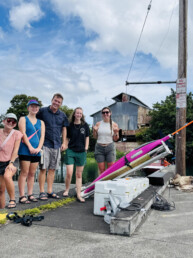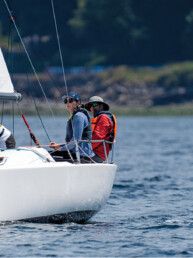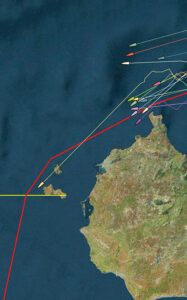 There were 110 boats entered in this year’s Rolex Middle Sea Race. Red Ruby, our Jeanneau SunFast 3300, was among the group of seven 33-footers that were the smallest boats in a fleet that also included eight boats over 70 feet. The race course is 606 miles from Malta, counterclockwise around Sicily, and back to Malta. Stromboli, a mark of the course, is an active volcano. If you read this paragraph out loud, it will take you 24 seconds, which will matter later in this story.
There were 110 boats entered in this year’s Rolex Middle Sea Race. Red Ruby, our Jeanneau SunFast 3300, was among the group of seven 33-footers that were the smallest boats in a fleet that also included eight boats over 70 feet. The race course is 606 miles from Malta, counterclockwise around Sicily, and back to Malta. Stromboli, a mark of the course, is an active volcano. If you read this paragraph out loud, it will take you 24 seconds, which will matter later in this story.
For Chris and I, our Middle Sea adventure began in Barcelona a week before the race started. We needed to deliver Red Ruby 700 miles to Malta for the start. Our delivery was a rather uneventful four days, but it did give us a nice opportunity to reacquaint ourselves with the boat, which we hadn’t seen since finishing Fastnet in July. It was warm, so our sea boots stayed on the dock.
Malta, if you’ve never been, is a unique remote island outpost smack dab in the middle of the Mediterranean Sea. On arrival, it has all of the appearances of a walled fortress, a role it has played many times over the last millennium. The start of the race would be in Grand Harbour, surrounded by the ancient city walls that provide stadium viewing to the start of this famous offshore yacht race. Appropriately, the start signal is a cannon.
We were set to race Red Ruby doublehanded, as we typically do — our preferred way to go sailing that we honed for many years on the Salish Sea before starting to sail internationally. The speed of the fleet, though, was unusual. Out of 110 boats, we had the 104th fastest IRC rating, meaning we were nearly the slowest boat in the fleet. Adding to the challenge, the Middle Sea Race is known for offering a wide range of conditions. Indeed, we would see everything from near zero to 30 knots from every direction. We carried nine headsails and spinnakers on Red Ruby and we ended up using every one of them!
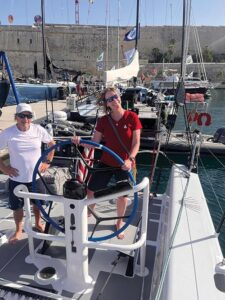
Right after the starting cannon fired, the wind died. What looked to be a downwind start eventually became an upwind start, but it took us 10 minutes to get across the line. A cold front was working its way over the course and we saw wild changes in wind direction for the next few hours. By the time the wind settled into a 20 knot northerly behind the front, we had already done 10 sail changes and felt like we’d been in a boxing match. “Everyone has a plan until they get punched in the mouth,” said boxer Mike Tyson, and this was not at all how we planned to start a four-to-five-day race. By “cold” front, I mean the temperature dropped from the 80s to the 70s, still pretty warm to sailors from the Pacific Northwest.
After a tough night of reaching then beating in 20-25 knots, we were well positioned in our fleet and working our way through the narrow Straits of Messina, hugging the shore, tacking frequently, and trying to avoid the strongest adverse current. Hours went by as we worked our way north through the Straits. Though we looked for every possible opportunity, a break for either of us to get some rest was non-existent. With all of the sail changes and boat handling this complex course was requiring, the Middle Sea Race was proving to be a real challenge for doublehanded sailing.
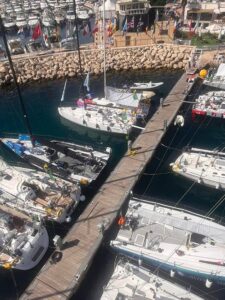
The second night found us crawling past Stromboli, which was actually a welcome treat. As we approached the island, a flash of red broke the otherwise pitch-black night. Lava was shooting straight up from the top of the volcano like a geyser. We were so close we could hear the eruption. The eruptions would repeat eight times as we sailed past.
Our fleet of little boats and doublehanders were quite close together approaching the western end of Sicily, and we had been enjoying pleasant VMG running with a kite all day. These gentle conditions were forecast to end, however, and we would soon transition to a tough upwind leg to the small island of Pantelleria, south of Sicily. Working through the transition from northeasterlies to the southeasterlies proved decisive. On Red Ruby, we opted to stay away from the Sicilian coast as the breeze dropped to almost nothing ahead of the southeasterly shift. The rest of our fleet did not. By morning, much to our surprise, we had a 20-plus mile lead over the next boat in our divisions (IRC 6, ORC 6, Doublehanded). But the race was barely half over, so anything could happen.
The next morning, we escaped the clutches of Lampedusa, the southwestern most island of the course, and began an 80 mile close reach towards Malta and the finish line. The new northwesterly was stronger than the models suggested. Red Ruby loves to reach and we were flying. As we closed on Malta and regained cell reception, the tracker said we were second overall. To win the Rolex Middle Sea Race we needed to finish before 8:51:11 p.m. We had 33 miles to go and needed to average more than 8 knots in a 33-foot boat. The bigger boats ahead of us were going less than 7 knots.
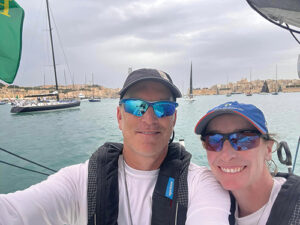
This was an overnight race at the end of October, so the dark came fairly early in the evening. As we approached Malta, it was blowing 20 knots and we couldn’t find the last mark of the course, backlit by the urban coastline, until we nearly ran into it. After rounding the mark just 1 mile from the finish, a high-speed ferry, similar to a large Victoria Clipper and going 30 knots, cut across our path. We luffed up and slowed to let the ferry pass in front. It was still blowing 20 knots. After four-and-a-half days, we sailed into Marsamxett Harbour and crossed the finish line. The time was 8:51:35. We missed the overall win by 24 seconds.
We didn’t win the Rolex Middle Sea Race, but we certainly had an epic adventure, sailed our hearts out, and created a mountain of fantastic memories that we will treasure for the rest of our lives. The days after the race were a repeated celebration. People we’d never met before come up to congratulate us. Many girls and women came up to Chris and asked to share a photo. Couples sought us out to tell us they were interested in doublehanded racing. People were inspired. We sure felt like winners!
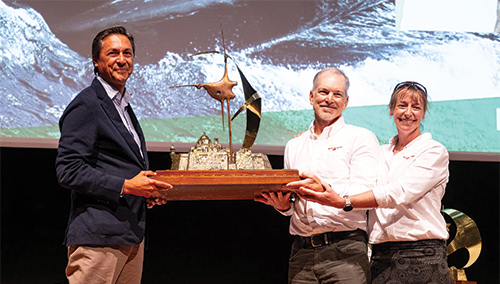
That wraps up the 2023 season for Red Ruby. What a fantastic year that started in France in April with races in the Solent in May and June, IRC Doublehanded Europeans and Fastnet in July, which netted us (Jonathan, Alysoha, Carl, Chris, and Justin) a 2nd Overall in the UK Doublehanded Offshore Series, ORC Doublehanded Worlds in Barcelona (and a win!) in September, and the Middle Sea Race nail-biter in October. It is clear our unique partnership has been a success and it is in large part due to the partnership that has pushed us all to great results and a wonderful season of sailing memories. We’re grateful for our teammates, for these amazing opportunities to sail internationally, and to all of you.
